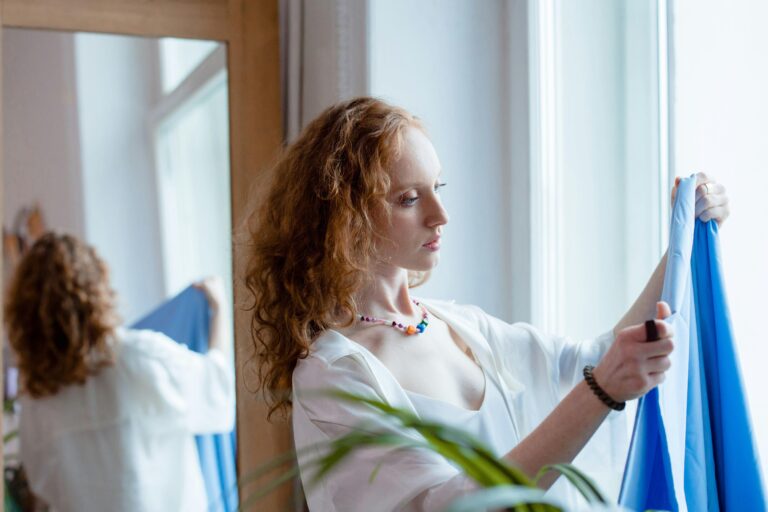As I am trying on the latest heap of Zara clothes with the air conditioning famously set to -17 celsius in their dressing rooms, I overhear a conversation from the cabin next door: “… This dress has shoulder pads, but I mean, if you don’t like them, you can get rid of them easily.”
I am a strong believer that you shouldn’t try to change things that are not supposed to be changed. Tailoring an A-line style dress to a cinch-waisted House of CB lookalike is like trying to get that festival-going, skirt-chasing dude to commit to a monogamous relationship – it’s just not gonna work.
The inconsistent sizing
One of the main reasons why we resort to buying ill-fitted dresses is of course, the budget. There’s no way around it: we now live in an era where fashion is as fast as a hot dog, but affordable to most. The downsides? To name a few… I’ll start with the inconsistency of retailers’ sizing.
Normally, I am a size S. But sometimes I am an XS. Or an M. It depends on the cut, shape, bloatedness, mood, gods, PMS, the weather… you name it. Fast fashion stores have got their work cut out for them: in order to keep their prices low, amongst other things, they need to mass produce garments and accommodate a large population.
The problem is that not only do women’s bodies vary from one to another, but also there are slight (and not so slight) differences in how women are built depending on the region where they come from. This means that retailers such as Zara, Shein, or H&M who are targeting a large population are highly unlikely to make garments that fit all shapes and sizes.
However, despite these obvious plot holes, their offer remains more or less the same in every country. Since COVID, online shopping has lived to an all time peak, and for an industry that is galloping towards online retail being its main business model, the sizing needs to be more nuanced than it is at this time.
The island of misfit clothes
Another reason why we buy clothes that don’t really fit is, of course, delusion. Do we really take them to the tailor’s? What actually happens to them? To the dress that was too long for us but was on sale, or to the pants we’d said we’d alter to fit us but never got around to it? In my closet, nothing. More often than not, they end up collecting dust.
This study shows that consumers will hold on to ill-fitting clothes for a variety of reasons, the most powerful being sentimental value. Adding emotional value to clothes is not unusual, and it is what marketing strategists count on while adding fuel to the fire on our consumerist-stricken minds.
If we think twice when shopping for an item, it will lead to a more thought-out wardrobe. How do we avoid overconsumption when it comes to clothes? I’ve turned to an expert on ethical fashion, Tena Lavrenčić (@thinkingthreads).
“The first and most important step to avoid overconsumption is to slow down, ” Tena says. “ When it comes to sizing, this can take a few forms.”
Tena shares some of her tips and tricks. “To start with, I never trust the size on the label and always take more time to look beyond that number. Whether I’m shopping online, in person, or in a vintage or contemporary store, I learned a long time ago that the size is more of a guideline, rather than the “correct choice”. Instead, I always try it on or look for the garment’s measurements if I’m buying online. I keep a note on my phone with all my measurements, including those that I know change depending on the time of the month or the comfort I’m looking for. Though this is not a mistake-free approach, it usually is much more accurate than selecting arbitrary sizes like “M”, “L”, and so on.”
one-size-fits-all approach is not the dream
Tena’s advice brings up a lot of thoughts. Maybe, just maybe, the act of buying clothes we’ll try to make fit by altering them is simply another rite of passage. In our 20s, we go out of our way to try and make it work with dresses, friends, and boyfriends, but in our 30s we’ve learned that a dress sitting idle is as bad as a friend around who we can’t really be our genuine selves, or a dude who is just “not in that place right now”.
When it comes to clothes, a one-size-fits-all approach is not the dream. Not every item is supposed to fit everyone, the perfect dress is either the one that fits you on the spot or the next one you’ll find. You can’t change the course of water, and most importantly – why would you?

I am writing this while musing on whether I should try this one last time to alter a dress I bought for a wedding. Just a tad. At the waist. Maybe this time it’ll work. Maybe tailoring can transform your pieces to be perfectly suited to your body… What are your thoughts?



